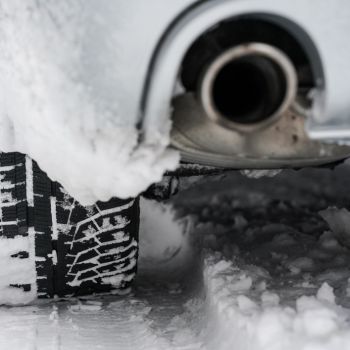 Your car’s exhaust system is integral to vehicle performance, diverting and neutralizing gases from the combustion process to better manage carbon monoxide production. This role influences the engine performance and the amount of noise it generates.
Your car’s exhaust system is integral to vehicle performance, diverting and neutralizing gases from the combustion process to better manage carbon monoxide production. This role influences the engine performance and the amount of noise it generates.
Its location places the exhaust system close to the ground, which means winter weather can wreak havoc, impacting its performance and your safety. Whether from ice, rock salt or potholes that form after a storm, understand how common winter weather hazards affect your exhaust system.
Road Debris
Moisture seeping into the pavement contributes to potholes. Uneven pavement, as well as chunks of debris can affect your exhaust system directly, denting or loosening parts.
Salt and Snow
The accumulation of ice and snow on the ground exposes your car’s undercarriage and exhaust system to high amounts of moisture. Throw rock salt into the mix and this area begins to rust very quickly from this highly corrosive substance.
These factors have a multi-faceted effect:
- Moisture accumulates inside the exhaust system, particularly the muffler.
- These parts begin to rust through moisture and rock salt exposure.
- Based on the location of rust, your car may expel high concentrations of carbon monoxide fumes or divert them toward the cabin.
In response, you’re advised to wash your car following a storm, paying attention to the undercarriage to dislodge any salt accumulation.
Digging Your Car Out
No matter if your car slides into a snowbank or you’re digging it out after two feet of snow fell overnight, these conditions can plug the exhaust system with snow and ice. If you ignore this risk, the gases that pass through the exhaust system back up and can migrate to the interior of your vehicle, exposing everyone to toxic amounts of carbon monoxide.
When attempting to drive out:
- First check the tailpipe for any snow, ice or other debris.
- Keep the windows open. Even if the tailpipe is clear, tall walls of snow may still direct exhaust gases back toward your car.
- Don’t run the engine constantly as you’re attempting to dig and drive out. Turn it on periodically to limit gas exposure.
Moisture Exposure
Driving your car in short bursts – under 20 minutes – causes moisture to accumulate inside the exhaust system. In turn, your vehicle can’t heat up and burn away the water vapor. Instead, moisture and ice begin to accumulate in the exhaust system, potentially freezing and contributing to rust. Along with holes, this combination of factors can lead to cracked pipes, damaged gaskets and broken hangars.
Signs of Damage
Be aware of the signs pointing to exhaust system damage, including:
- Roaring, rattling or vibrating as you drive, which is a sign of a cracked pipe, broken gasket or damaged muffler
- The exhaust system sounds like it’s hissing
- Your car seems to go through more gas than normal
- Your car takes longer to accelerate or experiences a delay
- You notice a strong smell around your vehicle
- You spot dark gray or blue-colored smoke coming from the tailpipe
When it comes to your exhaust system, issues don’t resolve themselves. Contact DaSilva’s Auto Body to have your exhaust system inspected and repair any rust-related damage. Schedule an appointment today!




